The Dubai Air Show was bookended by bad weather. Sunday's opening saw sandstorms call off the day's flying displays; while on the final day, the whole event was called off after heavy winds and rain hit the region overnight.
That didn't stop the dealmaking, however, with deals worth up to $200 billion processed, making it the largest ever order book taken at an air show.
With the Gulf carriers – Emirates, Etihad and Qatar Airways – together with Sheikh Mohammed bin Rashid Al Maktoum, the ruler of Dubai, playing a prominent role, it was clear that the region is pushing itself as a major player in the aviation world. And while growing power of the Gulf carriers means big money for the American and European aircraft manufacturers respectively, there is a concern that the Gulf and Middle East aviation is expanding too quickly for demand to catch up
(Read more: Gulf airlines lay down the gauntlet)
Boeing vs Airbus
With so much being made about the Gulf carriers, the state of Middle East aviation and the weather, the Boeing-Airbus rivalry - which usually dominates air show proceedings - was somewhat pushed aside.
Boeing kicked off the show on Sunday by announcing 259 orders for its new 777X, totaling over $95 billion at list prices. Airbus made its own mark too, with Etihad taking on 50 A350s and 36 A320s, plus the purchase rights for a further 30, an order totaling $26.9 billion. Emirates' announced that it was ordering an additional 50 A380s, bringing the Emirates fleet of the double-decker plane to 140.
The U.S. aircraft manufacturer sells its Dreamliner and 777X products as having greater seating capacity --250-400 passengers on certain routes -- than Airbus' A350 carries only 250-350 passengers in a typical three-class seating layout. Airbus has stressed that its A350 has a larger range than the Dreamliner, and that this aspect of an aircraft is what is more crucial to most airlines.
(Read more: Boeing: Build 777 where it makes sense)
For Peter Morris. chief economist at Ascend, Boeing's focus on size is the right one. "The 'right sizing' of the aircraft is the most important factor. Range/distance capability is a relevant factor for very few routes. Indeed, where an aircraft built for long range use is used on shorter or medium distances, it will be carrying a lot of unnecessary structural weight."
Still, John Strickland, director at JLS Consulting, said it's not appropriate to talk about winners and losers in the battle for orders. "In terms of profile, Boeing got the upper hand with all these orders for the 777X and a chunky order for 737s from flydubai," Strickland told CNBC. "Airbus would have been, to a degree, relieved by the big order for the A380 double-decker from Emirates which puts that program on a firmer footing."
(Read more: Dubai Air Show takes off with multibillion-dollar splurge)
Dubai bubble?
For the first time this year's Dubai AirShow took place at Dubai World Central (DWC), where the Dubai Government is building a new "airport city" for roughly 900,000 people, with Al Maktoum International replacing the city's currently overstretched airport. The airport is designed, once opened, to accommodate 160 million passengers a year.
With such large numbers and orders being thrown about at the air show, there are concerns that Dubai is over-estimating its ability to become the global hub of aviation at the expense of such established centers as Heathrow, Atlanta and Tokyo.
Strickland said that the Middle East is clearly already an aviation hub. "It is amongst, if not the most, visionary part of the aviation world," Strickland said. "They're looking ahead with a sense of realism in a trading sense. They rely on trade, they recognise they're not fundamentally oil economies, and aviation is the linchpin to the trade of the 21st century: people and goods."
Carsten Schaeffer, Lufthansa's Vice President for sales and services in south east Europe, Africa and the Middle East, told CNBC that the infrastructure projects undertaken in the Middle East show Europe that it must start to upgrade its facilities to deal with larger passenger numbers and new technology. However, Schaeffer was not worried about Europe losing its status as a hub.
"Well, the population of Europe is 300 million," Schaeffer said, "If you fly to Asia from Europe you're on a non-stop flight for 12 hours, which gives you the right rest. If you transfer in Dubai, you wake up in the middle of the night, you walk around for three hours and you continue you onto Asia. I think there's a market for everybody and everything."
According to Airports Council International, Dubai logged the highest number of international passengers in August, at 5,939,337. Paris was second with 5,621,024 passengers passing through the Charles De Gaulle terminal.
Marco Tulio Pellegrini, the current COO of Embraer Executive Jets, told CNBC that the Middle East was clearly a new hub for modern aviation travel.
"Latin Americans are flying to Doha, Dubai and Abu Dhabi," he said. "There are direct flights today every day. I took a flight from Sao Paulo to Dubai and there was a lot of Japanese people in the plane. Instead of flying to Europe, they are flying to Middle East and from the Middle East to other locations. It's convenient, it reduces the time.
"I do see the Middle East becoming a centre of gravity to Asia."
— By CNBC's Kiran Moodley. Follow him on Twitter @kirancmoodley




